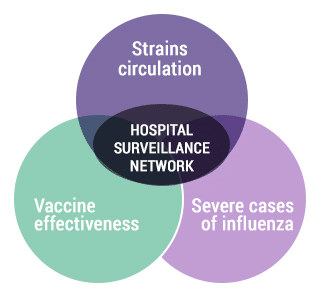Download the presentation
of the GIHSN
To inform policy decisions, national health authorities need to understand the burden of influenza disease and the impact of current vaccination programs in their countries. The Global Influenza Hospital Surveillance Network (GIHSN) is a platform able to generate strong epidemiological and medical evidence on the burden of severe influenza and the public health impact of influenza vaccines.
The GIHSN was initiated by Sanofi Pasteur in 2011 to fill the gap in epidemiology and public health knowledge. The GIHSN gathers several sites affiliated with national health authorities (see Implementing partners).
Background
According to the World Health Organization (WHO), seasonal influenza epidemics affect an estimated 5–15% of the total population worldwide, with 3–5 million cases of severe illness, resulting in 250,000–500,000 deaths. However, few data are available for many parts of the world where active surveillance is lacking. In addition, the viruses and the severity of influenza epidemics vary greatly between years and geographical areas. To address the rapidly evolving antigenicity of circulating influenza viruses, twice annually, the WHO re-evaluates the viruses that should be included in the seasonal influenza vaccines.
To inform policy decisions, national health authorities need to understand the burden of influenza disease and the impact of current vaccination programs in their countries.
High-quality, active surveillance networks are needed to better understand influenza epidemiology and therefore better control influenza epidemics. Data from existing sentinel physician networks are used in several countries to conduct annual studies on the effectiveness of vaccines in preventing medically attended influenza like illness (ILI). These networks, however, do not collect data on the impact of influenza infection on hospitalization or on the impact of influenza vaccines on influenza-related hospitalization, which substantially influence evaluation of the benefits and cost-effectiveness of influenza vaccines.
Active surveillance networks are also powerful advocacy instruments for highlighting the often-underestimated impact of influenza. While hospital surveillance systems already exist for detecting outbreaks of respiratory viruses, few focus on the actual burden of serious influenza cases using the specific outcome of laboratoryconfirmed influenza ; instead, the burden is most often estimated from hospital databases using criteria prone to various biases.
Rational and scientific objectives
Severe cases of influenza requiring hospitalization are probably the most influential factors in term of flu vaccination advocacy and cost-benefit evaluation of vaccination. In addition, little is known about the effect of influenza vaccine on the prevention of severe disease.
Indeed, previously published studies are prone to various biases. A design based on a network of hospitals is easier to standardize for quality insurance reasons and easier to coordinate than a General Practitioners (GP) network approach. Finally the availability of diagnostic capacities at hospital make influenza case ascertainment more reliable.
The GIHSN has three main objectives :
- Evaluate the burden of severe influenza disease, defined as hospitalization related to community-acquired influenza or complications following an influenza infection;
- Quantify the distribution of the different influenza viruses (A(H1N(H3N2), B/Yamagata, and B/Victoria) among these severe cases; and
- III. Measure the effectiveness of influenza seasonal vaccines to prevent these hospitalizations using a test-negative design.


Comments are closed.